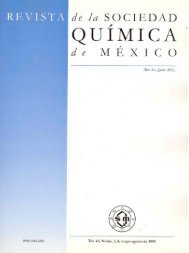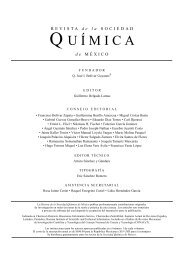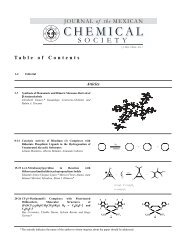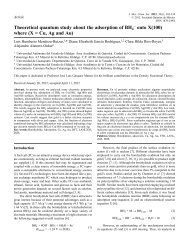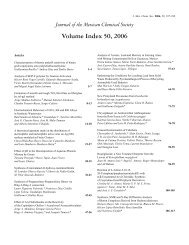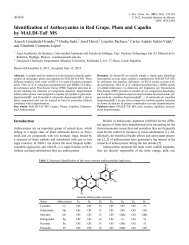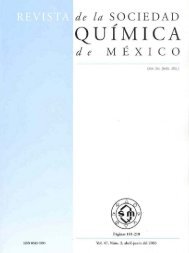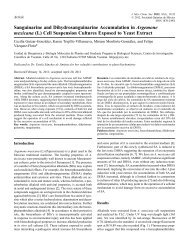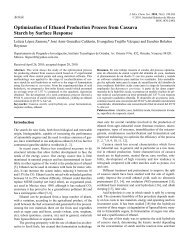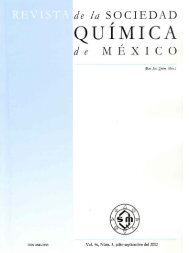SMQ-V043 N-001_ligas_size.pdf - Journal of the Mexican Chemical ...
SMQ-V043 N-001_ligas_size.pdf - Journal of the Mexican Chemical ...
SMQ-V043 N-001_ligas_size.pdf - Journal of the Mexican Chemical ...
Create successful ePaper yourself
Turn your PDF publications into a flip-book with our unique Google optimized e-Paper software.
Instrucciones para los Autores<br />
(1H, dd, J 2β,2α = J 2α,3β 10.5 Hz, H-2α), 3.95 (3H, s, CH 3 O-C-<br />
3’), 3.92 (3H, s, CH3O-C-8), 3.89 (3H, s, CH 3 O-C-4’), 3.83<br />
(3H, s, CH 3 O-C-2’), 3.79 (3H, s, CH3O-C-5’), 3.61 (1H,<br />
dddd, J = 10.5, 3.5, 5.5, 10.5 Hz, H-3), 2.96 (1H, ddd, J 4α,4β =<br />
16.0, J 4α,3β = 10.5, J 4α,5 = 1.0 Hz, H-4α), 2.90 (1H, ddd, J =<br />
16.0, J 3β,4β = 5.5, J 2β,4β = 1.0 Hz, H-4β); RMN 13 C (CDCl 3 ,<br />
125 MHz, asignaciones por APT y HMQC) δ 149.67 (C-5’),<br />
147.60 (C-7), 147.15 (C-3’), 147.12 (C-8a), 145.50 (C-2’),<br />
141.95 (C-4’), 134.80 (C-8), 128.90 (C-1’), 124.20 (C-5),<br />
115.00 (C-4a), 107.10 (C-6), 70.28 (C-2), 61.89 (OCH 3 -C-4’),<br />
61.51 (OCH 3 -C-2’), 61.00 (OCH 3 -C-3’), 60.90 (OCH 3 -C-8),<br />
56.25 (OCH 3 -C-5’), 31.84 (C-3), 31.32 (C-4); EMIE m/z (int.<br />
rel.): 376 [M] + (73), 224 (100), 209 (42), 152 (16), 151 (38),<br />
121 (14). Anal. C 63.65%, H 6.68%, calcd para C 20 H 24 O 7 , C<br />
63.82%, H 6.43%.;<br />
Las referencias deberán ser enumeradas en orden de<br />
aparición en el manuscrito, entre corchetes y antes del signo<br />
de puntuación, y deben representar citas adecuadas de otros<br />
trabajos en el área. A continuación se ejemplifica el formato<br />
para las referencias:<br />
1. Clark, T. D.; Buriak, J. M.; Kobayashi, K.; Isler, M. P.;<br />
McRee, D. E.; Reza Ghadiri, M. J. Am. Chem. Soc. 1998,<br />
120, 8949-8962.<br />
2. Vanden Berghe, D. A.; Vlietinck, A. J., in: Methods in<br />
Plant Biochemistry, Vol. 6, Hostettmann, K., Ed., Academic<br />
Press, London, 1991, 47-70.<br />
3. Lehn, J.-M. Supramolecular Chemistry. VCH, Weinheim,<br />
1995.<br />
Se emplearán las abreviaturas de las revistas, los términos<br />
técnicos y la nomenclatura adoptadas por <strong>Chemical</strong> Abstracts.<br />
Las figuras y las tablas no deben incluirse en el texto principal.<br />
Las tablas con su título, la lista de títulos de las figuras, y<br />
las figuras, cada una en páginas diferentes, deberán incluirse<br />
después de las referencias. La mayoría de la paquetería de<br />
cómputo para crear gráficas, figuras o esquemas permiten al<br />
usuario seleccionar el formato para salvar el archivo correspondiente.<br />
Se preferirá el formato TIFF y el formato Post-<br />
Script encapsulado. Las ilustraciones deben diseñarse para<br />
aparecer en una columna o dos de la página, con el fin de optimizar<br />
el espacio disponible.<br />
Instructions for Authors<br />
Editorial Policy<br />
The Revista de la Sociedad Química de México (Rev. Soc.<br />
Quím. Méx.) is <strong>the</strong> <strong>of</strong>ficial journal <strong>of</strong> <strong>the</strong> Sociedad Química de<br />
México and is devoted to <strong>the</strong> advancement <strong>of</strong> our understanding<br />
<strong>of</strong> chemistry. It will primarily publish original contributions<br />
<strong>of</strong> research in all branches <strong>of</strong> <strong>the</strong> <strong>the</strong>ory and practice <strong>of</strong><br />
chemistry in its broadest context. The journal will also publish<br />
reviews, feature articles, technical notes and comments on<br />
recent progress in active areas <strong>of</strong> chemical research. The preferred<br />
languages <strong>of</strong> submission are Spanish and English.<br />
Papers are submitted on <strong>the</strong> understanding that <strong>the</strong> subject<br />
matter has not been previously published or submitted for<br />
publication elsewhere. Authors must accept full responsability<br />
for <strong>the</strong> accuracy, content and selection <strong>of</strong> <strong>the</strong> data presented.<br />
All papers are sent to referees who recommend <strong>the</strong> Editor on<br />
<strong>the</strong> acceptance or rejection <strong>of</strong> <strong>the</strong> script. Referee’s names are<br />
not disclosed, but <strong>the</strong>ir comments are forwarded to <strong>the</strong><br />
authors. Authors submitting a manuscript do so on <strong>the</strong> understanding<br />
that if it is accepted for publication, copyright <strong>of</strong><br />
<strong>the</strong>ir article shall be assigned to Sociedad Química de México.<br />
General Guidelines for Manuscript Preparation<br />
Manuscripts must be prepared with a word processor and be<br />
printed double spaced on a laser printer, and submitted in quadruplicate<br />
to Dr. Guillermo Delgado, Editor, Revista de la<br />
Sociedad Química de México, to <strong>the</strong> address <strong>of</strong> <strong>the</strong> Sociedad<br />
Química de México. All pages <strong>of</strong> <strong>the</strong> manuscript should be<br />
numbered. Accepted manuscripts should be resubmitted on<br />
disk. The disk should contain <strong>the</strong> final version with <strong>the</strong> text and<br />
graphics stored in separate files. Text can be submitted using<br />
Micros<strong>of</strong>t Word, Word for Windows or Word Perfect. Graphics<br />
and formulae can be submitted using any <strong>of</strong> <strong>the</strong> major chemistry<br />
drawing packages. Formulae, figures, graphics and<br />
schemes should be stored in separate, suitable named files.<br />
Page 1 should contain <strong>the</strong> article title (brief and informative),<br />
author(s) name(s) (given and family names, <strong>the</strong> corresponding<br />
author should be indicated with an asterisk, use<br />
superscript to indicate different addresses), complete affiliation(s)<br />
(<strong>the</strong> corresponding author's mailing address, phone<br />
number, fax number or e-mail address should be included).<br />
Page 2 should contain an abstract (both in English and<br />
Spanish, about 80 words).<br />
A suggested organization <strong>of</strong> an article is: Introduction,<br />
Results and Discussion, Experimental, Acknowledgements and<br />
References. All <strong>the</strong> sections <strong>of</strong> <strong>the</strong> paper must be presented in<br />
a concise and clear manner. The measurements and data<br />
should be given in international unit system, and abbreviations<br />
should be used consistently through <strong>the</strong> text. Avoid reiteration<br />
<strong>of</strong> information. The discussion should present <strong>the</strong> new results<br />
and relate <strong>the</strong>m to existing knowledge in <strong>the</strong> field. Complete<br />
X-ray data should be deposited at an appropiate international<br />
data Institute, which is <strong>the</strong>n cited in a reference. If a representation<br />
<strong>of</strong> <strong>the</strong> crystal structure is to be included, it should be<br />
accompanied by pertinent crystallographic data, method <strong>of</strong><br />
collection, and methods <strong>of</strong> structure solution and refinement.<br />
The experimental section must contain all <strong>the</strong> information<br />
necessary for reproducibility. All new compounds should be<br />
fully characterized with relevant spectroscopic data. For physical<br />
and spectroscopic data, <strong>the</strong> following general style must<br />
be used:




